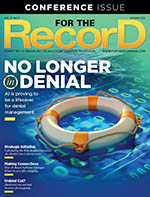Autumn  2025 Issue
2025 Issue
Unkind Cut?
By Jennifer Lutz
For The Record
Vol. 37 No. 3 P. 24
Medicaid cuts are bad business for hospitals.
The cuts to Medicaid in the One Big Beautiful Bill Act have made headlines for their potential effect on hospital systems, particularly those in rural areas. How will it impact budgets, and what can hospitals do to prepare? When considering these questions, it is important to track when aspects of the law will take effect. The cuts will affect hospitals and nursing homes in major ways: fewer patients, less funding, less support for education, more charity treatments, and overdue bills.
The One Big Beautiful Bill Act is projected to cost an estimated 7.8 million people Medicaid coverage, according to the Congressional Budget Office’s estimate, meaning fewer paying patients. As it stands, hospitals that depend on Medicaid revenue are facing a significant shortfall. The One Big Beautiful Bill Act also affects Affordable Care Act marketplaces at a time when enhanced tax credits are set to expire, potentially cancelling coverage for an estimated 8 million people. Together, nearly 16 million Americans are projected to lose their health care coverage.
Rural Communities Hit Hardest
Providers are about to lose millions of paying patients. “Medicaid patients are paying patients,” says Leonard Marquez, the senior director for government relations and legislative advocacy for the Association of American Medical Colleges.
According to the Kaiser Family Foundation, Medicaid covered at least 25% of in-hospital visits for 30 states in 2023, with 10 states exceeding 30%. New Mexico leads the nation with 32% to 46% of adults covered by Medicaid; 61% of all children living in New Mexico are Medicaid recipients. In Pennsylvania, 3 million people depend on Medicaid, according to the Hospital and Healthsystem Association of Pennsylvania (HAP).
“Medicaid is not just a lifeline for 3 million Pennsylvanians who rely on the program for coverage, but it is also a critical funding source that hospitals depend on to care for everyone in our communities,” says HAP CEO Nicole Stallings. “Reducing health care coverage makes Pennsylvanians less healthy, increases hospitals’ burden of uncompensated care, and raises health care costs for everyone.”
How much hospitals depend on Medicaid depends on several factors, and they receive varying degrees of reimbursement. For example, the Office of Health Strategy in Connecticut estimates a payment of 87 cents on the dollar for Medicaid patients, while the HAP estimates a 74-cent reimbursement for every dollar spent in Pennsylvania.
The cuts will have the greatest impact on rural communities. “Rural hospitals are closing. If you look at the data, we’re losing rural hospitals, we’re losing rural providers,” says Richard Carmona, MD, MPH, 17th Surgeon General of the United States and distinguished laureate professor at the University of Arizona. “Within the United States, we’re going to have big swaths of property with minimum health care coverage because that’s where poor people who depend on Medicaid live. Cuts to Medicaid are going to cost us hospitals and health care providers.”
Nearly 1 in 4 people living in rural areas are covered by Medicaid. In Vermont, Wyoming, South Dakota, Mississippi, Montana, and Kentucky, at least half of Medicaid recipients live in rural areas. Recently, the National Rural Health Association partnered with Manatt Health to estimate the impact of the One Big Beautiful Bill Act on rural communities. Estimates put financial losses at 21 cents out of every dollar received in Medicaid funding.
“About half of Pennsylvania’s rural hospitals—which often care for a greater percentage of patients with Medicaid coverage—are operating at a loss, largely because payments do not reflect the actual cost of providing care,” Stallings says. “On average, rural Pennsylvania hospitals are reimbursed 74 cents for every dollar they spend caring for patients covered by Medicaid. Reducing payments even further or increasing uncompensated care will force more rural hospitals to reduce services or, in the worst cases, close.”
It’s not just hospitals that suffer: The costs of care for uninsured Americans are passed on to taxpayers and patients. Higher taxes and fewer resources affect the whole population.
Contraction and Expansion
Rural communities are already suffering. Between 2010 and 2021, 136 rural hospitals closed. About 65% of rural hospitals have a shortage of primary care physicians. Just 4% to 5% of incoming medical students are from rural areas.
The lack of care is closely linked to preventable deaths. According to the CDC, many early deaths in 2022 could have been prevented in rural areas, including 17,000 from heart disease, 6,000 from chronic lower respiratory disease, 6,000 from cancer, and 2,800 from stroke. Nearly 4 in 10 Medicaid enrollees under age 65 in rural communities have a chronic health condition. Without health insurance, those chronic conditions often go untreated and result in hospital visits with high costs.
“The question is, when will people show up to get the care they need?” Marquez says. “If people don’t have [Medicaid] Advantage, they’ll miss out on preventive care, and we know that if you catch something early, you can identify and treat it earlier. It’s less expensive, and you have better outcomes.”
Looking at the success of Medicaid expansion offers some insight into how Medicaid cuts may harm patients and hospitals, especially those in rural communities. To get a sense of how reduced access to Medicaid will affect hospital systems and society, compare Medicaid expansion states to those without the program.
According to Statista, 15.6% of US adults in Medicaid nonexpansion states reported avoiding medical care due to cost. Skipping preventive care is bad news for economies; screenings for high blood pressure, diabetes, and heart disease are among preventive measures that can save billions annually.
On the other hand, Medicaid expansion is associated with improved hospital financial performance and lowered likelihood of closure, particularly for rural hospitals. Expansion programs also see significant increases in the number of visits to providers for services such as mammograms and substance use disorders in rural areas, and higher staffing levels in rural community health centers.
Funding Cuts
“I’m coming at it from a very specific point of view, which is academic medical centers and teaching hospitals. Our members train the residents, do [National Institutes of Health] research, and do other funded studies. They care for a disproportionate number of Medicaid members,” Marquez says.
When those centers lose Medicaid funding, they lose research funding. For example, New York teaching hospitals receive $1.2 billion annually from Medicaid GME, roughly 40% of their graduate medical education funding.
“AAMC represents US medical schools, nearly 500 academic health centers and teaching hospitals,” Marquez says. “Our institutions are the places where the health care workforce training and lifesaving medical research come together—patient care, education and training, community engagement, and research. When we talk about Medicaid cuts, they don’t happen in a vacuum. They don’t just stick to Medicaid patients. Those are cuts that are felt across the entire academic medical center or hospital.”
A key aspect of the bill involves caps on provider taxes (hospitals, nursing homes, etc). Why wouldn’t a hospital want to pay less taxes? The reason is state governments use those taxes as part of their Medicaid contribution, which the federal government matches.
Here’s why it matters: Today, providers (hospitals and nursing care homes) pay the state up to 6% in taxes towards Medicaid. If a hospital earns $100, six of those dollars go to Medicaid. The federal government then matches that contribution with an additional $6, and the total contribution to Medicaid, based on that one provider, is $12. The One Big Beautiful Bill Act caps the provider tax at 3.5% by 2031, so that $12 Medicaid contribution becomes $7. Multiply that difference by every provider, and it means significantly less federal support for state Medicaid programs.
Work Requirements
New work requirements will bump many from Medicaid programs—complicated paperwork will make it worse. Medicaid prevents job loss from resulting in insurance loss, which is foundational to a state’s societal fabric, particularly in a country where half of the population is one emergency away from being homeless. For many, Medicaid is the bridge between jobs.
HHS will issue implementation guidance by the end of 2025, and states must enforce the work requirement by the end of 2026. To qualify for Medicaid, individuals over 18 without a disability will need to prove they have greater than 80 hours per month working, volunteering, studying (at least part time), or fulfilling community service. States will need to verify compliance at application and then every six months.
What can hospitals do to prepare? First, hospitals can lobby their state government to apply for an extension. If states request and demonstrate a “good faith effort,” the deadline may be extended under temporary waivers, no later than December 31, 2028.
A significant risk of the work requirement is complications with reporting. In Arkansas, where 25% of enrollees lost coverage during a piloted work requirement program, most coverage losses were due to reporting problems, rather than a lack of compliance. A 2019 report by the Arkansas Center for Health Improvement identified the major issues that caused people to lose Medicaid, including issues the state encountered when contacting enrollees, people’s confusion over what was required of them, and challenges navigating the state’s online portal for reporting.
Internet access was also a problem. Enrollees were instructed to verify work participation through the online portal, but many people lacked access to broadband internet. Users could phone a call center for help, but the center had limited hours. Transportation to report compliance in person was also a boundary. Finally, the state did not initially launch a large communications plan to explain the new process, and many people were unaware or confused by the new reporting guidelines.
States can prepare for the federal change to Medicaid qualifications with broad communications campaigns, simplified online portals, outreach programs, and biannual reminders so people don’t face gaps in coverage.
Emergency Care
As patients miss out on preventive care, chronic illness will likely get worse. More hospital visits and unpaid bills will put greater pressure on hospitals and providers.
“In one scenario, you can have someone come in for a preventive screening, or on the other hand, you have someone who shows up in the emergency department because they didn’t have preventive care. [Emergency care] costs the hospital more money,” Marquez says. “I think the most important thing I would say about all of this is, I think there’s this perception that ‘Don’t worry, the hospitals will figure it out,’ and I’m worried that’s not the case. I am worried about the hospital closures, and as someone who represents academic hospitals, the teaching faculty, and the providers, I worry about all the missions they represent, all the things we worry about as a society.”
Emergency department visits are costly, and that’s where uninsured people usually end up. Unlike Medicaid patients, emergency department visits for the uninsured end up as charity cases, unpaid bills that hurt a hospital’s bottom line. Federal law (the Emergency Medical Treatment and Labor Act) requires hospitals to provide emergency care regardless of insurance status or ability to pay.
“If we really look at this as a business case, there are places we can save money—more prevention services, easier access, telemedicine, telehealth, wearables to track data, all of those things are a cheaper investment with a long-term return that reduces the cost of care,” Marquez says.
Communities can start now by promoting preventable measures, such as healthier food choices, urban planning that promotes more movement, health education, social programs to support mental well-being, and communication campaigns that make sure everyone eligible for Medicaid has the tools to apply and stay in compliance.
— Jennifer Lutz is a freelance journalist who covers health, politics, and travel. Her writing has appeared in The Guardian, The Independent, New York Daily News, BuzzFeed Politics, The Local ES, HealthCentral, Today’s Geriatric Medicine, Medscape, Pittsburgh City Paper, and more.



